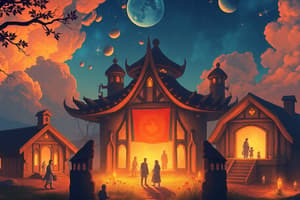Podcast
Questions and Answers
Which type of community is characterized by high-rise buildings and busy streets?
Which type of community is characterized by high-rise buildings and busy streets?
- Urban Communities (correct)
- Rural Communities
- Town Communities
- Suburban Communities
All communities need recreational activities to thrive.
All communities need recreational activities to thrive.
True (A)
What describes a rural community?
What describes a rural community?
Small towns and farmland
The five essential needs of all communities include recreation, education, transportation, communication, and __________.
The five essential needs of all communities include recreation, education, transportation, communication, and __________.
Match the community type with its characteristic:
Match the community type with its characteristic:
Which of the following is NOT an example of transportation?
Which of the following is NOT an example of transportation?
A suburban community typically has a population larger than a rural community.
A suburban community typically has a population larger than a rural community.
Give an example of an activity that falls under recreation.
Give an example of an activity that falls under recreation.
Understanding and sharing thoughts and ideas with others is known as __________.
Understanding and sharing thoughts and ideas with others is known as __________.
Which community type is most characterized by residential areas with schools and parks?
Which community type is most characterized by residential areas with schools and parks?
What is the role of government in a community?
What is the role of government in a community?
Flashcards are hidden until you start studying
Study Notes
Definition of a Community
- A community consists of individuals who share common values and beliefs.
Types of Communities
Rural Communities
- Characterized by small populations, often found in small towns or on farmland.
- Example features include open spaces, fewer buildings, and strong local identity.
Urban Communities
- Defined by large populations residing in major cities.
- Notable characteristics include high-rise buildings, busy streets, and a rich variety of cultural activities.
Suburban Communities
- Comprised of residential neighborhoods with resources in proximity.
- Population size is medium—larger than rural communities but smaller than urban areas.
- Common features include nearby schools, parks, and shopping centers.
Five Essential Needs of All Communities
Recreation
- Involves physical activities that promote health and well-being.
- Examples include running, playing soccer, and swimming.
Education
- Focuses on learning and knowledge acquisition.
- Includes experiences such as attending school, going to college, and participating in local classes (e.g., cooking classes).
Transportation
- Involves the movement of people from one location to another.
- Common modes of transportation include trains, planes, and cars.
Communication
- Encompasses the sharing of thoughts and ideas among individuals.
- Examples include talking, texting, and writing letters.
Government
- Refers to organizations or individuals responsible for maintaining safety and order within communities.
- Key figures include the President, the Mayor, and law enforcement such as the police.
Quick Review Summary
- Community: Group sharing values and beliefs.
- Types of Communities: Rural (small towns, farms), Urban (large cities), Suburban (neighborhoods).
- Essential Needs: Recreation, Education, Transportation, Communication, Government.
Studying That Suits You
Use AI to generate personalized quizzes and flashcards to suit your learning preferences.




